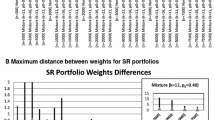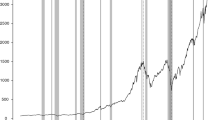Abstract
The mean-variance model for portfolio selection requires estimates of many parameters. This paper investigates the effect of errors in parameter estimates on the results of mean-variance analysis. Using a small amount of historical data to estimate parameters exposes the model to estimation errors. However, using a long time horizon to estimate parametes increasers the possibility of nonstationarity in the parameters. This paper investigates the tradeoff between estimation error and stationarity. A simulation study shows that the effects of estimation error can be surprisingly large. The magnitude of the errors increase with the number of securities in the analysis. Due to the error maximization property of mean-variance analysis, estimates of portfolio performance are optimistically biased predictors of actual portfolio performance. It is important for users of mean-variance analysis to recognize and correct for this phenomenon in order to develop more realistic expectations of the future performance of a portfolio. This paper suggests a method for adjusting for the bias. A statistical test is proposed to check for nonstationarity in historical data.
Similar content being viewed by others
References
M. Best and R. Grauer, On the sensitivity of mean-variance efficient portfolios to changes in asset means: Some analytical and computational results, Rev. Fin. Stud. 4 (1991) 315.
V.K. Chopra, Mean-variance revisited: Near-optimal portfolios and sensitivity to input variations, J. Investing (1993), to appear.
V.K. Chopra, C.R. Hensel and A.L. Turner, Massaging mean-variance inputs: Returns from alternative global investment strategies in the 1980s, Manag. Sci. (1993), to appear.
V.K. Chopra and W.T. Ziemba, The effect of errors in means, variances, and covariances on optimal portfolio choice, J. Portfolio Manag. (Winter 1993) 6.
E.J. Elton and M.J. Gruber,Modern Portfolio Theory and Investment Analysis, 4th ed. (Wiley, New York 1991).
J.D. Jobson, Confidence regions for the mean-variance efficient set: An alternative approach to estimation risk, Rev. Quant. Fin. Accounting 1 (1991) 293.
J.D. Jobson and B. Korkie, Putting Markowitz theory to work, J. Portfolio Manag. (Summer, 1981) 70.
P. Jorion, Bayes-Stein estimation for portfolio analysis, J. Fin. Quant. Anal. 21 (1986) 279.
P. Jorion, Portfolio optimization in practice, Fin. Anal. J. (Jan.–Feb. 1992) 68.
J.G. Kallberg and W.T. Ziemba, Mis-specification in portfolio selection problems, in:Risk and Capital, eds. G. Bamberg and A. Spreman, Lecture Notes in Economics and Mathematical Sciences 227 (Springer, New York, 1984).
H.M. Markowitz,Mean-Variance Analysis in Portfolio Choice and Capital Markets (Basil Blackwell, New York, 1987).
R. Michaud, The Markowitz optimization enigma: is “optimized” optimal?, Fin. Anal. J. (Jan.–Feb. 1989) 31.
W.F. Sharpe,AAT: Asset Allocation Tools, 2nd ed. (Scientific Press, South San Francisco, CA, 1987).
Author information
Authors and Affiliations
Rights and permissions
About this article
Cite this article
Broadie, M. Computing efficient frontiers using estimated parameters. Ann Oper Res 45, 21–58 (1993). https://doi.org/10.1007/BF02282040
Issue Date:
DOI: https://doi.org/10.1007/BF02282040




